Decandle Day: Japanese Black Pine [Bonsai]
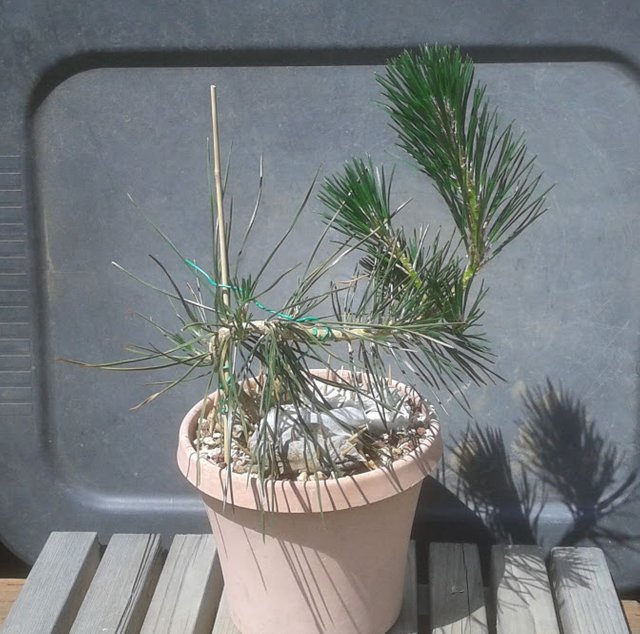
In this article, I will present another in-depth look at one of my developing bonsai trees.
Although I am focused on documenting the decandling phase on this young Japanese Black Pine, I will also present some past photos of what this new tree looked like not long ago. It looks quite different than it did earlier this year. This is one of the newest trees in my bonsai collection.
Origin Story
.jpg)
Originally this tree came in a small plug of soil. I kept the soil and roots undisturbed to ensure any necessary #mycorrhizae colony can spread out into the new bonsai soil. Without the necessary symbiotic fungus to support the roots, some trees are unable to survive, no matter how healthy the roots and fertile the soil is.
With the tree planted at a sharp diagonal, I knew it would give me some options later on to introduce bends and curves into the trunk.
This tree was provided to me by a professional arborist company as a free gift. With a bit of ingenuity, I modified the planting instructions to turn this tree into a bonsai, instead of an in-ground tree.
.jpg)
Following the guidance I received from learning about how to train #niwaki trees into zigzag shapes, I turned the tree into this new form.
The chopstick and wire helps to hold the tree firmly in the diagonal direction from the soil and roots that I wanted originally.
A separate loop of wire holds the tree into a sharp bend by pinning the upper branch directly down closer to the base. This is the first time I physically forced a tree to bend into such a severe change in shape.
Five Months Later
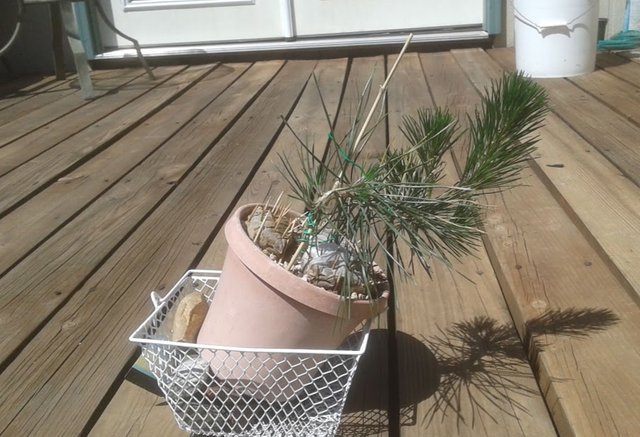
After applying full fertilizer treatment for the past three months, many new buds have formed, and now the candles are starting to open up.
A wire basket filled with rocks on one side provides a resting place for the bonsai pot. It leans at an angle to allow the sunlight to pull the candles upward. The bend in the candles are made by the sun entirely, without any physical force by me, or use of wire.
Closer Look
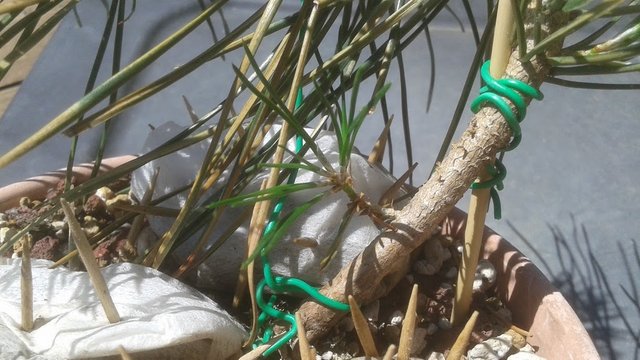
A small bud close to the base of the tree. It is being allowed to develop to partially fill in the space underneath the main branch.
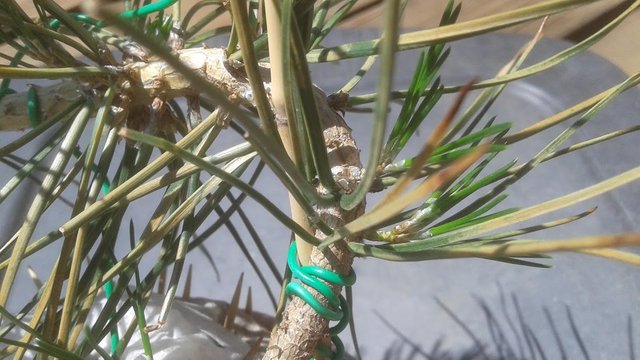
Many little buds forming on the spine of the tree along the bend. This is the ideal space to develop the first major side branch. One day, one of these buds will be selected to become dominant to occupy this space.
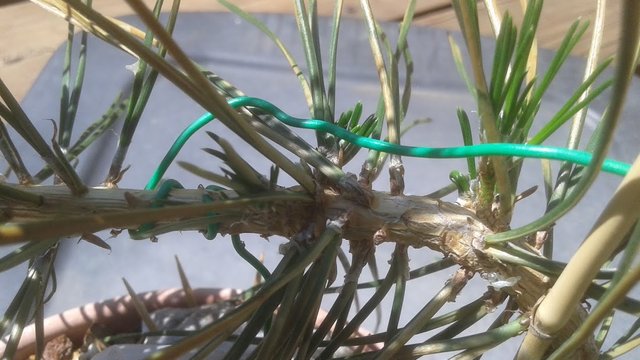
On the horizontal area, the tree has a few stronger buds.
Some of them are competing for the same space. In this decandling phase, I can select which ones to keep and which ones to remove.
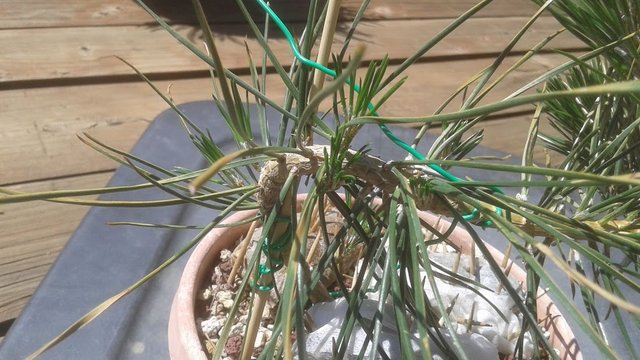
Overall, a nice fan shape of new needles forming along the bent portion of the spine.
Normally I would remove old dying needles around the buds, to force growth into the new area, but I was advised not to disturb the old needles.
This tree is still very young, and the old needles are still green. They are efficient at withstanding harsh sunlight and converting sunlight into food energy. Old green needles can also become future buds, where new needles may emerge.
A Little Pinch, This Won't Hurt
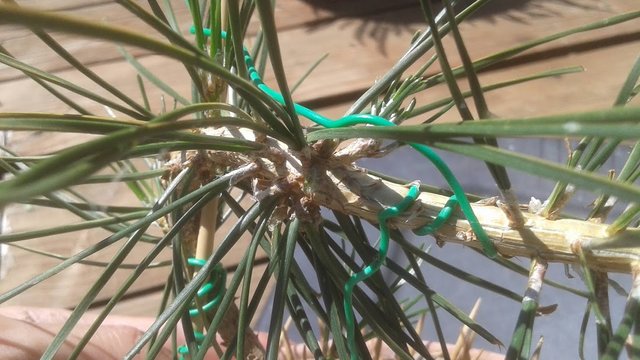
Above is one such location where I plucked off a bud. You can see the green circle where the scar still shows under the bend in the wire.
This time of year, candles can be plucked off by hand without use of scissors or blades. I was surprised how turgid and green the tissue was, because the surrounding wood is so dry and woody. It felt a bit like snapping open a succulent aloe leaf, only with less resistance.
Call me weird, but there is something thoroughly satisfying with breaking the candle between my fingers. Hidden inside is the most appetizing juicy green melon color imaginable. Snapping the candles is sort of like the enjoyment one receives from popping bubble wrap bubbles, only much more physically gratifying in feel! I can't describe it.
Five Important Decisions
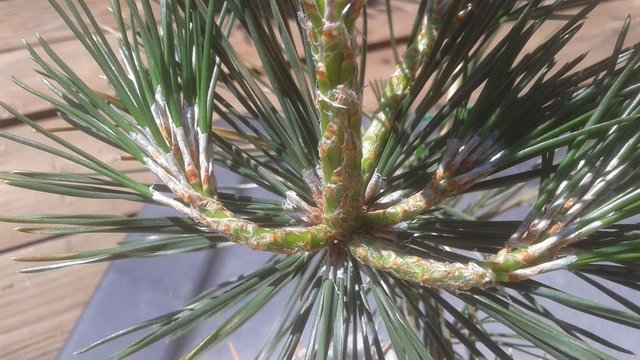
Here at the tip of the branch, five major candles formed.
The tree has been forcing most of its growth energy into supporting the largest central candle here. Adjacent candles have been collecting small bits of that energy. They are bigger than the tiny buds elsewhere on the tree, because they are blocked by fewer growth suppressing hormones inside the wood.
By removing some of these candles, some of the growth energy will be released back into other parts of the tree to support more back budding. Smaller candles will continue to develop larger.
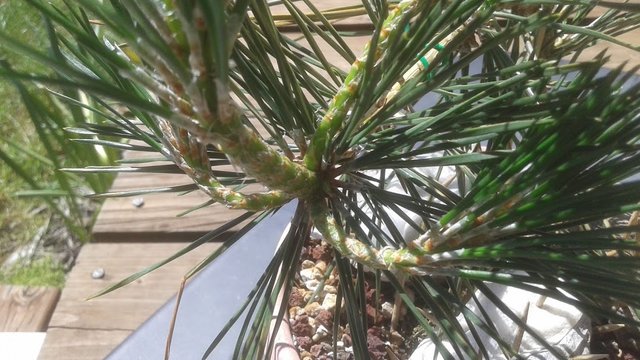
Snap!
The candle I removed first was the smallest candle.
I only want to leave two total candles sprouting here. I'll have to remove two more if I want this branch intersection to have an ideal shape for the tree.
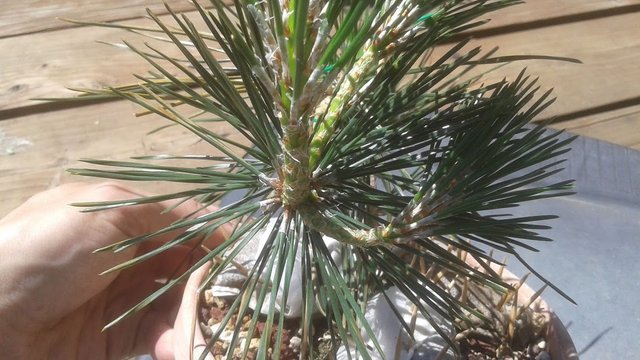
Snap!
Out of the two bottom branches, I had a hard time deciding which one I liked better.
Ultimately, I decided I wanted to remove the branch with less curve potential. I kept the candle on the right, because it looked like it was going to arch out much deeper as it continues to climb up into the light.
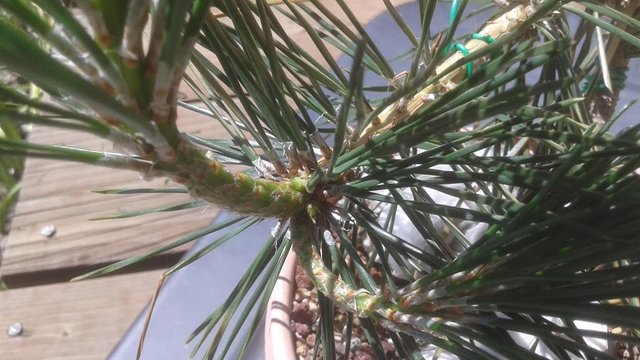
Snap! Third time's the charm.
Out of the two top branches, it seemed like a clear decision to maintain the large one, and remove the smaller one that was emerging at a 90 degree angle. The dominant branch has a nice curve that matches the curve on the other side of the tree.
The main candle will be allowed to grow undisturbed for now. I want the trunk to continue to grow in length a lot more, with many twists and bends introducing each new level of branches.
Decandling to Reduce Node Length
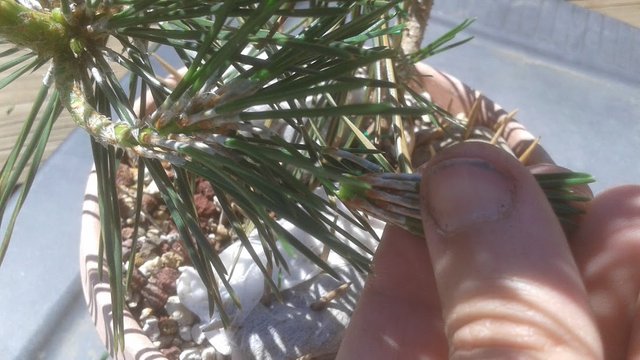
Snap!
This might seem like an unnecessary thing to do. From the research I have done.
By breaking the candles into a smaller size, this is how refinement of small needles and small branches is accomplished on a Japenese Black Pine.
Be sure to only snap the inner candle, and do not cut or break the tender new needles.
Normally, it is recommended to only leave 1/16 of an inch remaining on a candle at this time of year. However, at our bonsai club meeting I was advised to leave a bit more further space because this is a young tree. They were also not sure why my candles were bare under the new needles. We believe this is possibly what candles look like on a juvenile tree. I have to assume that needles will not be forming on the bare sections, and so I should be cautious about removing too much from the candle.
One day this severed candle will multiply into several new candles. A prickly pad of thickly packed green needles will define the space as a healthy side branch.
The Damage Is Done
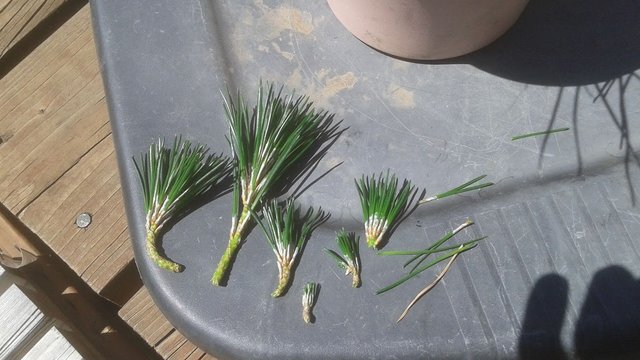
Here is everything removed from the tree.
Three candles removed from the main area. One candle shortened in height. A couple of weak buds were pinched off that were competing too closely with adjacent buds.
A few old needles feel off.
Final Results
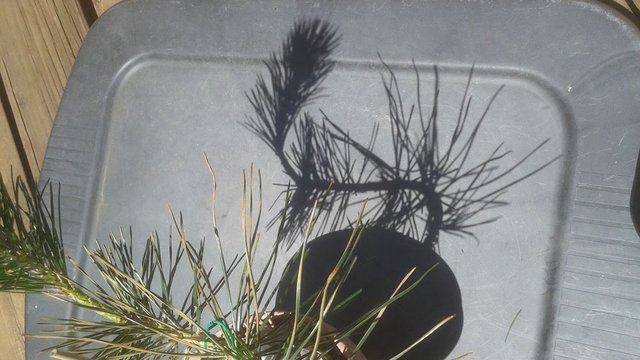
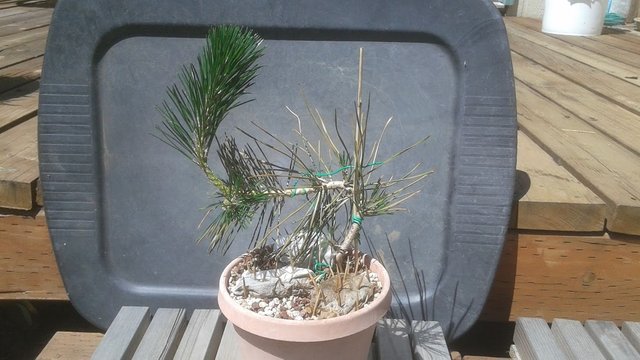
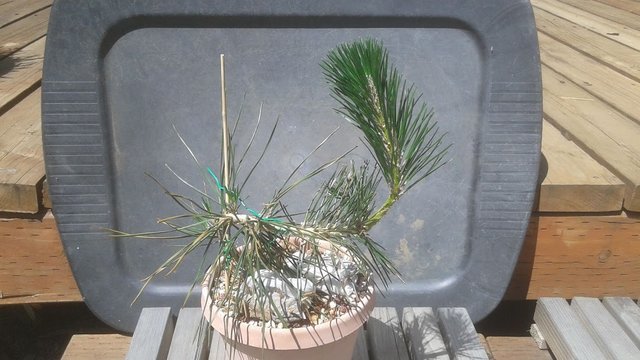
Future Plan
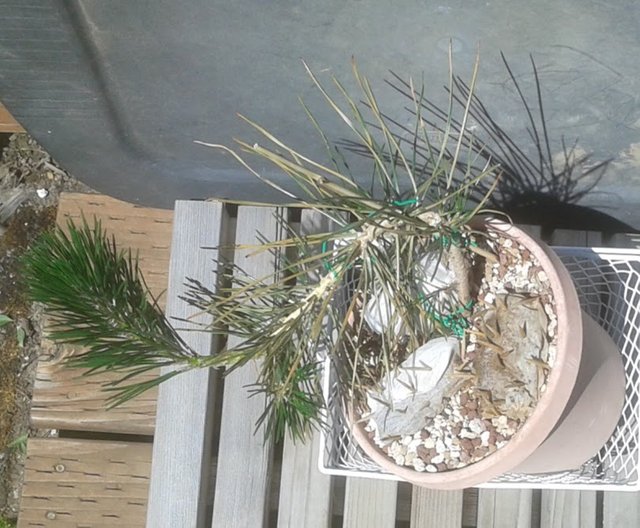
With the tree pot replaced in the basket, I rotate the angle slightly. This will allow the young candles develop a slight twist as they grow into the new upward direction to reach sunlight.
This tree will have to wait until August before it receives any further fertilizer treatment. I am not super great at explaining fertilizer needs, as I am still learning. My understanding is that after a Japanese Black Pine is decandled, it has lost a lot of plant tissue, and so there is less location inside the tree to store added nutrients which are already abundant.
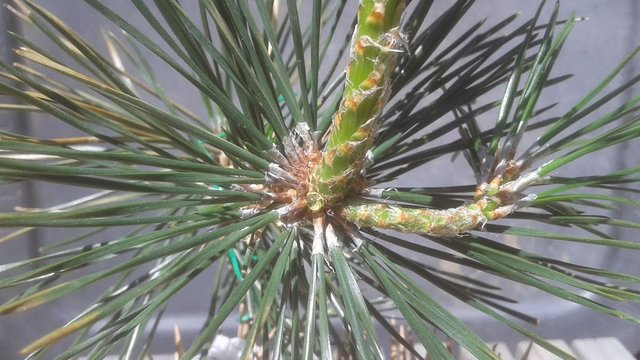
Watery sap is beading at all the sites where the candles were broken.
I have moved the tree into a shady space and watered the soil deeply. In the next few weeks I will be monitoring tree's health. Then I will move it back into the full sun once tree looks like it has recovered.
Wait until August and September to see if any new back-buds form. Japanese Black Pine is considered a two-flush pine species, meaning it can grow an entire set of buds only twice in one year.
#decandling #jbp #black-pine #japanese-blackpine #pruning #candles #needles #pine-needle #pine-needles #learning #instruction #teaching #diy #how-to

Ahaha beautiful thank for sharing my friend
I've always wanted to start a bonsai but I think I've learnt more from your photos than I have from all the books I've read. Thanks for the great photos, it will be nice to see how it develops.
Hi creativetruth,
Visit curiesteem.com or join the Curie Discord community to learn more.
hi @creativetruth
Your post is really interesting. I love flowers and plants, I have a friendship with them that makes me happy, I also think I know how to treat them quite well, but I never tried with a bonsai. Do you always want special care like this pine tree? it won't grow much if it's a bonsai, right?
congratulations and thanks for sharing with us
Probably right about that. Bonsai is all about tree maintenance to keep a tree healthy and small. The pot is the strongest element used for keeping the tree the small size. When watered correctly, the tree does not suffer starvation. If done right, a bonsai will be full life for hundreds of years and have a beauty that only grows.
but in the face of such immense nature, how does the need arise to hold back the growth of a tree?
There no need. I do lots of other silly things that run against the course of nature too. Owning a pet is a lot like taking care of a bonsai. It is possible to give it a happy life, but it will be very different than it would be in the wild. At least we get to spend time together that way.
Bonsai is a great hobby for people like me who can only afford a small home. I would plant a forest if I had the land to grow all the types of trees I love. Squirrels sometimes plant their favorite trees in my pots too.
you're right, it's a beautiful philosophy !! how did this passion come about?
Amazing @creativetruth I wonder how a pine Bonsai would turn out.
WOW so much patience and love to a plant. Amazing. Does Japanese Black pine has some sort of unique and special benefits to it that you did so much hard work growing this one. But honestly yeah amazing work here, I am plant lover myself and I am quite impressed by your work here. I feel I do like nothing for my babies.
Congrats on that Curie, well deserved. :)
Yeah, this is my first pine tree. Was very excited to have a Japanese Black Pine as my first one to practice on. Next to Juniper, this is one of the most popular trees to grow by bonsai experts. It requires unique timing and methods for pruning and fertilizing. Most of my trees are deciduous.
The attitude I go in with is, "So that's a challenge? I want to prove that I can do it!".
They are known for having long, sharp needles that become a dark forest green that is super vibrant.
Wooh thats nice to know - Juniper is also a tough one to grow. I did not know that.
Nice attitude you got there. :):)
There is so much skill and knowledge that is required to get the best results and never knew about these things that you have to do. I found this fascinating and how you end up manipulating the Bonsai into the shape you want.